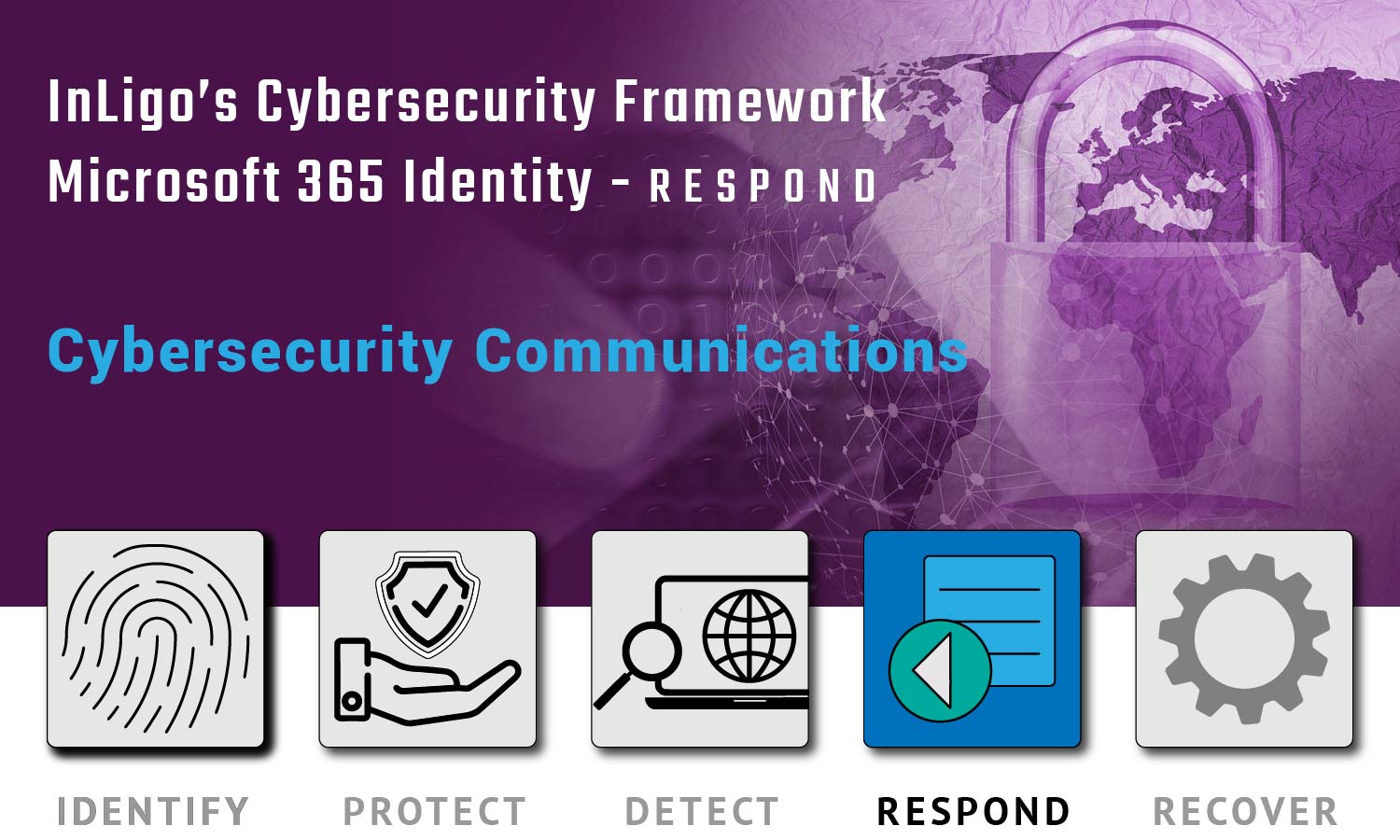
InLigo security guidelines and Microsoft 365 solutions that help foster your cybersecurity posture.
Cybersecurity Communications
Microsoft 365 cybersecurity communications refers to the guidelines and procedures for communicating with stakeholders about cyber security issues within an organization. This may include employees, customers, partners, and other relevant parties.
InLigo is a cybersecurity consulting firm that specializes in helping organizations improve their cyber security posture. Our team of experts can provide a range of services, including:
- Cybersecurity assessments: We can conduct assessments of your organization’s current cyber security posture and provide recommendations for improvement.
- Cybersecurity training: We can provide training to your employees on how to identify and respond to potential cyber security threats.
- Crisis communication planning: We can help you to develop a plan for how to communicate with stakeholders during a crisis, such as a major security breach.
- Cybersecurity incident response planning: We can assist you with developing a plan for responding to and addressing cyber security incidents.
Overall, Microsoft 365 cyber security communications and InLigo services can help organizations to effectively communicate with stakeholders about cyber security issues and take proactive steps to protect their data from potential threats.
WHAT IS YOUR SECURITY SCORE?
Communications Plan
A Microsoft 365 cyber security communications plan is a set of guidelines and procedures for communicating with stakeholders about cyber security issues within an organization. This may include employees, customers, partners, and other relevant parties.
Some key elements of a Microsoft 365 cyber security communications plan might include:
- A clear chain of command: This should specify who is responsible for communicating with stakeholders about cyber security issues and how decisions will be made about what information to share.
- A list of stakeholders: This should include a comprehensive list of all stakeholders who need to be informed about cyber security issues, along with their contact information.
- A set of guidelines for communicating about cyber security issues: This should include guidelines for what information to share, when to share it, and how to communicate it in a clear and concise manner.
- A set of templates for communicating about cyber security issues: This should include templates for different types of communications, such as press releases, internal memos, and customer notifications.
- A plan for crisis communication: This should include guidelines for how to communicate with stakeholders during a crisis, such as a major security breach.
Overall, a Microsoft 365 cyber security communications plan helps organizations to communicate with stakeholders effectively and efficiently about cyber security issues and ensure that they have the information they need to protect themselves and their data.
InLigo’s Discovery Questions
- Who is responsible for communicating with stakeholders about cyber security issues within the organization? Is there a clear chain of command for this process?
- Who are the stakeholders that need to be informed about cyber security issues within the organization? Do you have a complete and up-to-date list of these stakeholders, including their contact information?
- What guidelines does the organization have in place for communicating about cyber security issues? Do these guidelines cover what information to share, when to share it, and how to communicate it effectively?
- Does the organization have templates in place for different types of cyber security communications, such as press releases, internal memos, and customer notifications?
- Does the organization have a plan in place for crisis communication in the event of a major security incident? If so, who is responsible for implementing this plan and what steps are included?
- Are there any weaknesses or gaps in the organization’s current cyber security communication processes? If so, what steps can be taken to address these weaknesses?
Overall, these discovery questions can help to identify areas for improvement in your organization. Security communications will ensure that stakeholders have the information they need to protect themselves and their data.
Microsoft 365 Solution
- Microsoft Defender
- Self-Report
- Security Center
Business Case
A Microsoft 365 cyber security business case is a document that outlines the benefits and costs of implementing cyber security measures within an organization. It is used to justify the allocation of resources and budget for cyber security initiatives.
Here are some key elements that might be included in a Microsoft 365 cyber security business case:
- The current state of the organization’s cyber security posture: This should include an assessment of the organization’s current cyber security defenses and any vulnerabilities or weaknesses that have been identified.
- The potential impact of a cyber security incident: This should include an assessment of the potential financial, reputational, and operational impact of a security incident on the organization.
- The benefits of implementing cyber security measures: This should include a list of the benefits that the organization can expect to achieve by implementing cyber security measures, such as reduced risk of a security incident, improved compliance, and increased customer confidence.
- The costs of implementing cyber security measures: This should include a list of the costs associated with implementing cyber security measures, such as training, hardware and software expenses, and consulting fees.
- A cost-benefit analysis: This should include a comparison of the benefits and costs of implementing cyber security measures to determine whether the investment is justified.
Overall, a Microsoft 365 cyber security business case helps organizations to justify the allocation of resources and budget for cyber security initiatives and ensure that these initiatives are aligned with the organization’s business objectives.
Action Items
- Review and update the chain of command for communicating with stakeholders about cyber security issues: This may involve clarifying roles and responsibilities or updating the list of stakeholders.
- Create or update a list of stakeholders: This may involve identifying new stakeholders or updating the contact information for existing stakeholders.
- Develop or update guidelines for communicating about cyber security issues: This may involve establishing protocols for what information to share, when to share it, and how to communicate it effectively.
- Create or update templates for different types of cyber security communications: This may involve creating templates for press releases, internal memos, and customer notifications.
- Review and update the crisis communication plan: This may involve clarifying roles and responsibilities or adding additional steps to the plan to address potential scenarios.
- Conduct training for employees on cyber security communication: This may involve providing training on how to identify and respond to potential cyber security threats and how to communicate effectively with stakeholders.

